Serbian cuisine
Serbian cuisine (Serbian: српска кухиња / srpska kuhinja) is the traditional cuisine of the Balkan country Serbia, sharing characteristics with the rest of the Balkan nations (especially former Yugoslavia).
The national dishes include pljeskavica (a ground beef/pork patty), ćevapi (grilled minced meat), and Karađorđeva šnicla (Karageorge's schniztel). The national drink is the plum brandy šljivovica or Homemade rakija .
Serbian food is characterized not only of elements from Serbia, but of elements from the former-Yugoslavia as a whole. Peasantry has greatly influenced the cooking process. Due to numerous influences, Serbian cuisine has gathered elements from different cooking styles across the Middle East and Europe to develop its own hearty kitchen with an intricate balance of rich meats, cheese, fresh pastries and desserts.
In recent times, the Serbian diaspora has spread the cuisine across the world.
History
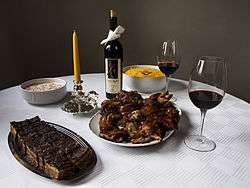
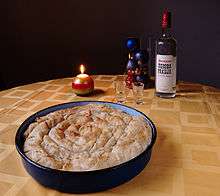
William, archbishop of Tyre, who visited Constantinople in 1179, described the Serbs: "They are rich in herds and flocks and unusually well supplied with milk, cheese, butter, meat, honey and wax".[1]
The first published cookbook in Serbia is The Big Serbian Cookbook (Veliki Srpski Kuvar), written by Katarina Popović-Midzina in 1877.[2]
The best known Serbian cookbook is Pata's Cookbook (Patin Kuvar), written by Spasenija Pata Marković in 1907; the book remains in publication even today.[3]
An old Serbian legend says that during the time of the 14th-century Serbian Empire, under the rule of Stefan Uroš IV Dušan, meals in the Serbian palace were eaten with golden spoons and forks. Historians say that mediaeval Serbian cuisine mainly consisted of milk, dairy produce and vegetables. Not a lot of bread was eaten, but when it was, the rich ate bread made from wheat and the poor ate bread made from oats and rye. The only meat consumed was game, with cattle kept for agricultural use.[4]
Overview
Most people in Serbia will have three meals daily, breakfast, lunch and dinner, with lunch being the largest in the Mediterranean fashion. However, traditionally, only lunch and dinner existed, with breakfast being introduced in the second half of the 19th century.[5][6]
It has a unique mix of various traditions; Serbian confectioneries often offer koljivo, baklava, nut roll and sachertorte.
A number of foods which are simply bought in the West, are often made at home in Serbia. These include rakija (fruit brandy), slatko, jam, jelly, various pickled foods, notably sauerkraut, ajvar or sausages. The reasons for this range from economical to cultural. Food preparation is a strong part of the Serbian family tradition.
Meals
Breakfast


Breakfast in Serbia is an early but hearty meal, although before breakfast most people usually take a cup of coffee, in modern times maybe an espresso. With the breakfast itself either a tea, milk, milk coffee, or cocoa milk is served, pastries or bread are served with butter, jam, yogurt, sour cream and cheese, accompanied by bacon, sausages, salami, scrambled eggs and kajmak.
- Various sorts of pastries (often with cheese or meat or filled with jam) (pogačice, paštete, kifle that in Serbian usage may or may not be crescent shaped and may be sweet, but, may also be sprinkled with salt crystals, kiflice, perece, buhtle, pletenice, štapići, zemičke, djevreci) and especially often:
- Burek
- Kačamak (also Cicvara) - a type of polenta
- Popara
- Proja (cornbread)
- Čalabrca
- Eggs
- Kajgana (scrambled eggs)
- Jaje na oko (fried eggs)
- Rovito jaje (soft-boiled egg)
- Kuvano jaje (hard-boiled egg)
- Various sandwiches
- Bread with something:
- Sudžuk (also appetizer)
Soups

There are two types of soups in Serbian cuisine: standard soups called supa, and soups with roux or eggs - called čorba. The most common are simple pottages made of beef or poultry with added noodles. Fisherman's soup (riblja čorba) and lamb soup (jagnjeća čorba) are considered to be delicacies.
- Goveđa supa (Consommé)
- Teleća čorba (veal ragout soup)
- Jagnjeća čorba (lamb ragout soup)
- Fisherman's soup
- Čorba od ječma i sočiva (Barley and lentil soup)
- Čorba od zelja i sira
- Čorba od spanaća, koprive ili zelja
- Corba od boranije
- Paradajz čorba (Tomato soup)
- Čorba od luka (Onion soup)
- Ljuta krompir čorba (Spicy potato soup)
- Čorba jajaruša (egg soup)
- Škembe čorba (tripe soup)
Main course
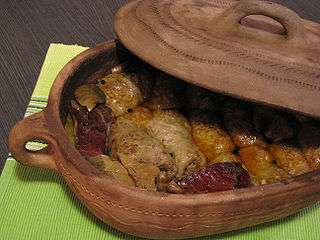
The main course is always a meat dish. Main courses that are not grilled include:
- Pečenje, Roasted meat (whole roasted pork, lamb and goat)
- Đuveč, stewed vegetables and pork similar to Ratatouille
- Karađorđeva šnicla (breaded rolled steak stuffed with kajmak and occasionally sliced ham and cheese)
- Kavurma (lamb or pig intestines)
- Moussaka (Musaka, made with aubergines/eggplant, potatoes or zucchini)
- Mućkalica (diced pork with a pepper and tomato hot sauce)
- Rinflajš
- Podvarak (stewed sauerkraut, usually with meat and bacon pieces)
- Prebranac, baked beans in sauce
- Tavče gravče, stewed vegetables, similar to Ratatouille
- Sarma (food)
- Tripes (škembići)
- Noodles with poppy (Rezanci s makom)
- Pihtije
- Pasulj (a thin bean stew)
- Punjene paprike, peppers stuffed with ground meat, onion, and rice
- Punjene tikvice, stuffed zucchini
- Grašak, Peas
- Wedding cabbage, (Svadbarski kupus) (cabbage cooked with smoked pork)
- Dumplings (valjušci or flekice) with potatoes or cabbage
- Meat and vegetables cooked under sač
Roštilj (Barbecue)

Grilling is very popular in Serbia. Grilled meats are the primary main course dishes offered in most restaurants. They are often eaten as fast food.
- Pljeskavica (patty) National Dish
- Ćevapčići (ground meat sticks) National Dish
- Vešalica (grilled strips of pork loin)
- Various sausages
- Mixed grill (mešano meso)
- Skewered kabobs (ražnjići)
- Leskovački roštilj (Leskovac grills)
Appetizers
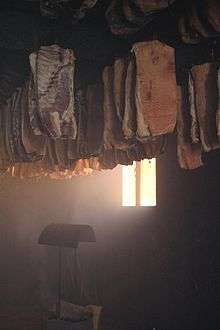
.jpg)
Meat products
Traditional Serbian meat products are simple ham, bacon, dry ribs and a kind of pork rinds called čvarci,[6] often made during svinjokolj. They are traditionally made by holding the meat to the wind and cold air and only later smoked[6] (except čvarci).
Here are selected some Serbian meat products, especially those which attained[7] protected designation of origin status:
Various kinds of sausages and similar more complex meat products were created under Austrian influence in Vojvodina.[6] They include:
- Sausage (kobasica)[6]
- Blood sausage (krvavice)[6]
- Head cheese (švargla)[6]
Dairy Products

- Buttermilk, known as kiselo mleko ("sour milk")
- Kajmak
- Yogurt
- Pavlaka, heavy soured cream (smetana)
- White cheese
- White cheese with walnuts from Babine, won the 2012 "best autochtonic cheese" award[8]
- Cream cheese
- Vurda, Sheep milk
- Sirac, unpasteurized cow's milk cheese
- Cheeses (see also Serbian cheeses)
- Kačkavalj (from caciocavallo), yellow sheep milk cheese
- Pirot caciocavallo
- Svrljig caciocavallo
- Krivi Vir caciocavallo
- white brined cheeses
- Sjenica cheese, sheep milk (traditionally)
- Homolje cheese
- Šar cheese (šarski sir), traditional sheep/cow milk hard cheese
- Pule cheese (pule), donkey milk cheese, most expensive cheese in the world
- Feta, curd
- Sirenje, brined cheese of goat, cow or sheep milk
- Vlašić cheese (Vlašićki sir), traditionally made in Bosnia
- Kačkavalj (from caciocavallo), yellow sheep milk cheese
Bread and porridges
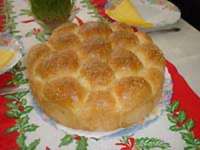
Bread is the basis of Serbian meals and it is often treated almost ritually. A traditional Serbian welcome is to offer the guest with just bread and salt; bread also plays an important role in religious rituals. Some people believe that it is sinful to throw away bread regardless of how old it is. Although pasta, rice, potato and similar side dishes did enter the everyday cuisine, many Serbs still eat bread with these meals.
In most bakeries and shops, white wheat bread loafs (typically 600 grams) are sold. In modern times, black bread and various graham bread variations regain popularity as a part of more healthy diets. In many rural households, bread is still baked in ovens, usually in bigger loafs. Also, the following breads and porridges are part of the traditional cuisine:
- Đevrek, ring-shaped bread-pastry
- Kačamak, made of boiled cornmeal, potato and, sometimes feta cheese or skorup (polenta)
- Pereca, baked snack of savory or sweet varieties (Pretzel)
- Pogačica, type of bread
- Masonica, bread with milk, sugar and kajmak or sirene (Popara)
- Soda bread
- Languš, deep-fried flat bread
- Mekike, deep-fried pieces of dough
- Pita, pocket flat bread
Pies
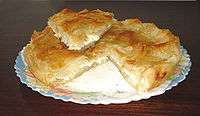
The Serbian word for pie is "pita", similar to Greek pita.
A number of Serbian pies are made with phyllo, called "kore" in the Serbian language. A common Serbian pie not made with phyllo is called "štrudla". To add to the confusion, it is not similar to strudel, but rather to the nut roll. Most commonly you would see two dominant varieties, sometimes made in pairs: Makovnjača (with poppy seeds) and Štrudla s orasima (with walnuts).
A Serbian pie could, in general, be called in two ways: according to its mode of preparation, and according to its filling (although not every pie is prepared with every filling). For example, a "bundevara" is a pie filled with pumpkin and could refer to either a savijača (made of rolled phyllo) or a štrudla (made of rolled dough). Both sweet and salty pies are made, and some pies could be prepared in the same way with either sweet or salty filling.
For an overview of Serbian pies, you may refer to this informative table:
| form → | ruffled phyllo | rolled phyllo | layered phyllo | rolled dough | |
| ↓ filling | ↓ Serbian name → | burek | savijača | štrudla | |
| white cheese | sirnica | ||||
| meat | |||||
| leaf vegetables, spinach | zeljanica | ||||
| leek | |||||
| mushrooms | |||||
| pizza topping | |||||
| white cheese and eggs | gibanica | ||||
| nothing | |||||
| sour cherries | |||||
| apples | |||||
| pumpkin | bundevara | ||||
| poppy seeds | makovnjača | ||||
| walnuts | orasnica | česnica (in Vojvodina) |
Salads
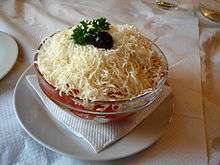
In Serbia, salads are typically eaten with the main course and not as an appetizer.
The simplest of salads are made of sliced lettuce, cabbage, sauerkraut, tomato, cucumber or carrot without any preparation or dressing at all. Oil, vinegar and salt could be added as a dressing, occasionally spiced with pepper or paprika. Beetroot or potato salads require cooking and oil, vinegar and salt.
More complex salads are prepared in a similar way, but by mixing several kinds of vegetables, together with white cheese, garlic and other spices. These include:
- Serbian salad (српска салата, srpska salata)
- Shop salad (шопска салата, šopska salata)
- Greek salad (Grčka salata)
- Kisele (ukiseljene) paprike (roasted green papers with garlic and vinegar) with garlic derived from Zimnica also called Turšija
Finally, there are salads with complex preparation that could even be eaten as a part of the main course:
- Russian salad (ruska salata)
- Tarator (Тартар)
- Urnebes salata
Relishes
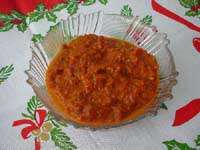
Sweets
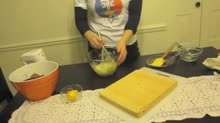

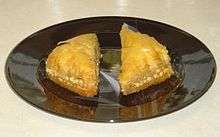

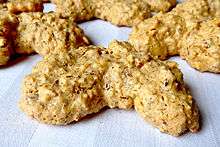
- Vasa's Torte (Vasina torta), traditional Serbian cake rich in chocolate, nut and orange flavour (see recipe in external links)
- Slatko, fruits in jelly (fruit preserves)
- Alva, flour-based and Nut-butter-based sweet confections.
- Baklava, sweet pastry made of layers of phyllo dough filled with chopped nuts and sweetened with syrup or honey.
- Bundevara
- Kompot, pieces of fruit in sugar syrup (compote)
- Doboš torta, five-layer sponge cake, layered with chocolate buttercream and topped with thin caramel slices.
- Grilijaš cake
- Jam (džem and pekmez - preserve)
- Kadaif (knafe), sweet pastry of Kanafeh layers
- Kitnikes, jelly sweets
- Knedle (Knedle sa šljivama – also called Gomboce in Banat)
- Kuglof
- Krofne, doughnuts filled with custard, chocolate, cream or jelly (Berliner)
- Krempita (custard pie)
- Makovnjača
- Medenjaci
- Oblande (Oblatne)
- Orasnice, a walnut cookie
- Palačinke (type of pancake)
- Plazma torta, torta of Plazma keks
- Profiterole (princes krofne)
- Serbian cherry pie (Pita od Višanja – sour cherries and walnuts with fillo dough)
- Salčići
- Šampita, whipped marshmallow-type dessert with fillo dough crust
- Šnenokle
- Španski vetar, cake that translates to Spanish wind
- Ratluk, sweet jelly confections (Turkish delight)
- Ruske kape
- Reform torte (reforma torta), multi-layered torte with chocolate butter-cream filling
- Sutlijaš, rice pudding with cinnamon
- Tatlije, sweet pastry
- Tufahije
- Tulumbe
- Urmašice, biscuits served in syrup
- Uštipci
- Vanilice
- Žito, ceremonial sweet made of wheat, walnuts and some raisins
Ritual


- Česnica, Christmas bread
- Koljivo, boiled wheat - ritual food during slava
- Slavski kolač, prepared for slavas.
Spices and seasoning
The spices and herbs that are used in Serbia the most are: salt, black pepper, parsley, celery leaves and dried powdered root, dill, cinnamon, ground paprika, ground chili pepper, and laurel are in widespread use,[6][9] Other spices sometimes used include white pepper, nutmeg, allspice, coriander, and clove.
Drinks
Non-alcoholic
High quality and quantity of fruit and abundance of water result in a number of high-quality fruit juices and mineral waters produced in Serbia, and being among its most widely known exports. There are few domestic carbonated soft drinks however. An interesting traditional soft drink, made from corn, now less commonly consumed is boza. Kvas is also being made by some breweries.
Serbian coffee, Turkish coffee prepared the Serbian way (домаћа кафа 'domestic coffee' or кафа 'coffee'. Especially strong coffee (without sugar and milk) is often referred to as 'Turkish' or 'black' coffee) is a traditional drink of Serbs. Tea is far less popular and mostly herbal teas are consumed, drunk on their own or as supplementary medicine.
Of dairies, yogurt is common, as are kefir and similar varieties.
The famous Serbian Knjaz Milos mineral water is considered a national brand and can be used in any meal, also with the traditional greeting sweets "Slatko".
Alcoholic
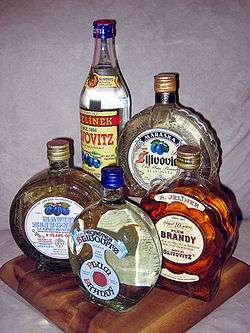
Rakija
Of distilled beverages, the most popular are various fruit brandies called rakija. Comparatively many people brew their own rakija, which is highly prized by friends and relatives. Rakija is famous for being smooth but very alcoholic and it is said that one cannot get a hangover from it. Serbian rakija is a prized commodity and is very difficult to find elsewhere in the world. Various kinds of rakija are named after fruit they are made of; among the most known ones are:
- Šljivovica (slivovitz, plum brandy), National Drink
- Šumadija tea,
- Lozovača (grape brandy)
- Viljamovka / Kruškovac (pear brandy)
- Klekovača,
- Jabukovača, applejack
- Stomaklija,
- Pelinkovac, (a wormwood liqueur milder than Absinthe)
- Medovaca (honey brandy)
Beer
Beer is widely enjoyed in Serbia, which has 14 breweries (see Beer in Serbia).
Wine
Kitchenware
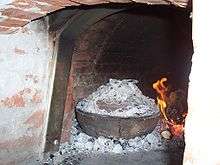
Some specific kitchenware for Serbian cooking include:
See also
- Culture of Serbia
-
 Serbia portal
Serbia portal -
 Food portal
Food portal
References
- ↑ William of Tyre, Historia Transmarina 20.4.
- ↑ Poglaviti majstori svakog krkanluka
- ↑ Istorija pisanja kuvara u Srbiji
- ↑ "Food « National Tourism Organisation of Serbia". www.serbia.travel. Retrieved 2016-03-17.
- ↑ Antonić, Dragomir (2006-07-23). Царство за гибаницу. Politika 33300 (in Serbian). Politika. p. 11.
- 1 2 3 4 5 6 7 8 9 10 11 12 Nikola Vrzić (December 28, 2000). "Sve srpske kašike" (Windows-1250). NIN (in Serbian). Retrieved 13 June 2012.
- 1 2 3 4 5 6 7 8 9 Списак ОГП
- ↑ Press Online :: Društvo :: Srpski sir pobedio švajcarski
- ↑ "http://www.ekapija.com/website/sr/page/82512" (in Serbian). Ekonomist magazine. 2006-12-11. External link in
|title=(help)
External links
| Wikibooks has a book on the topic of: Cookbook:Cuisine of Serbia |
- Nigella.com – English language recipe for Vasa's Torte (traditional birthday cake with origin from Paraćin, Serbia)
- SerbiaTouristGuide.com – includes Serbian recipes
- Slivovitz shop

